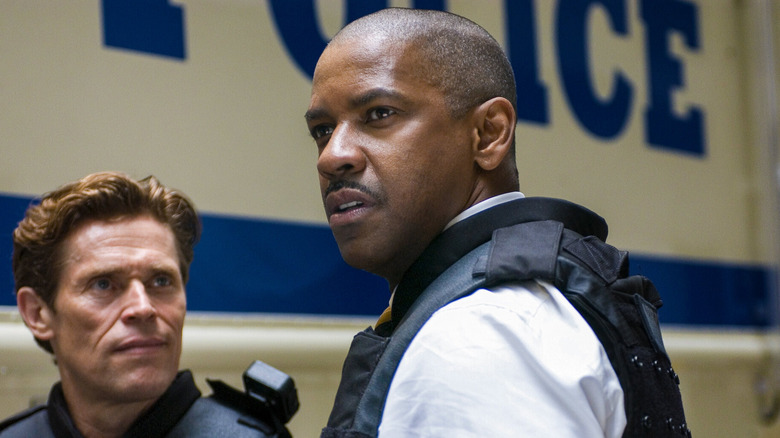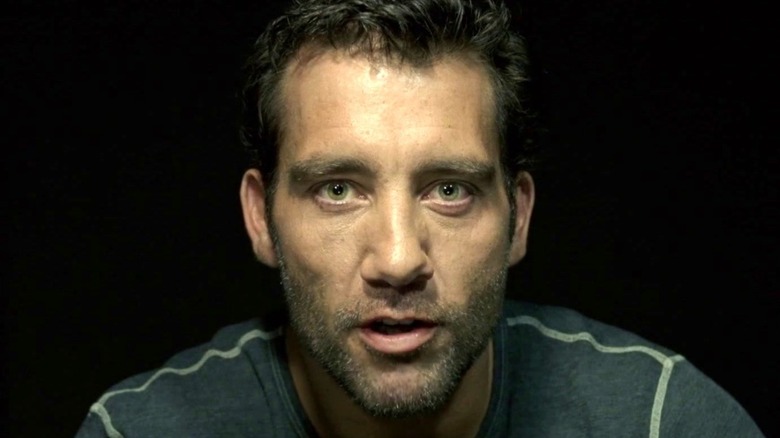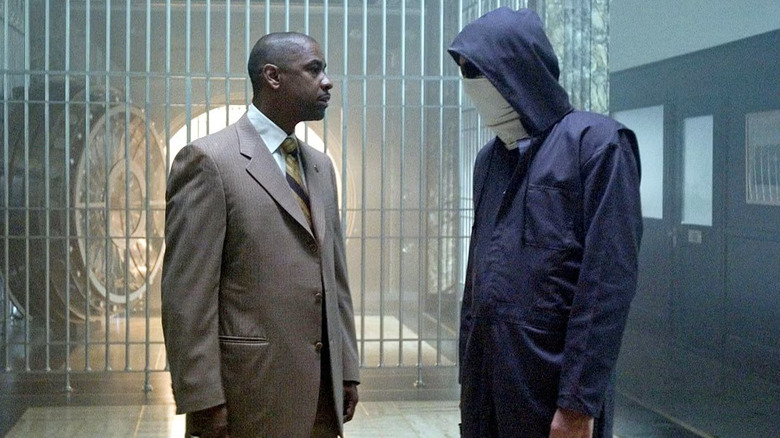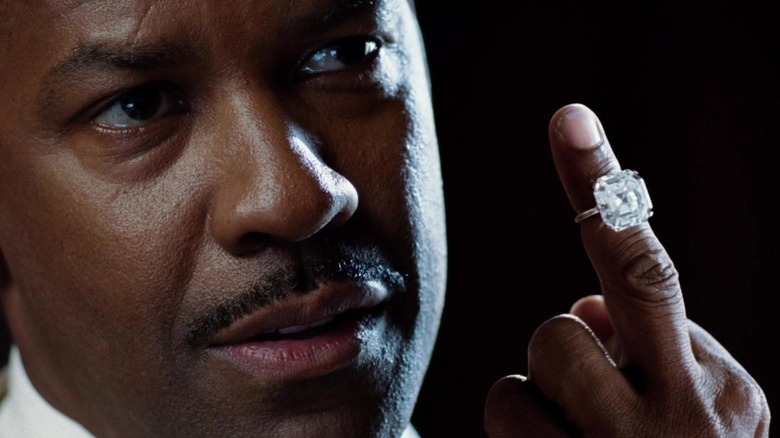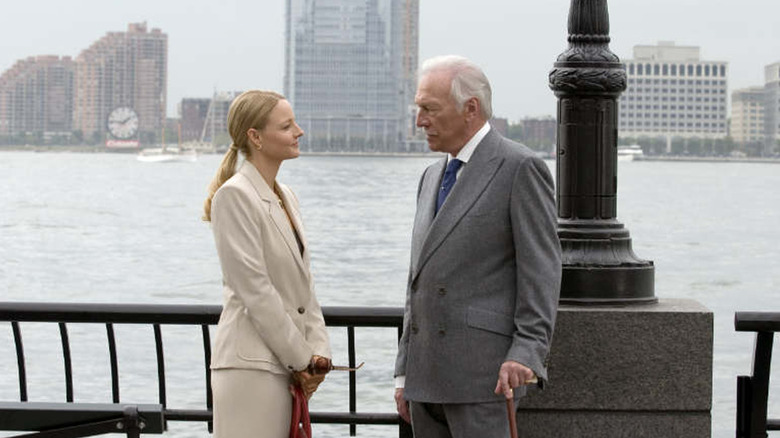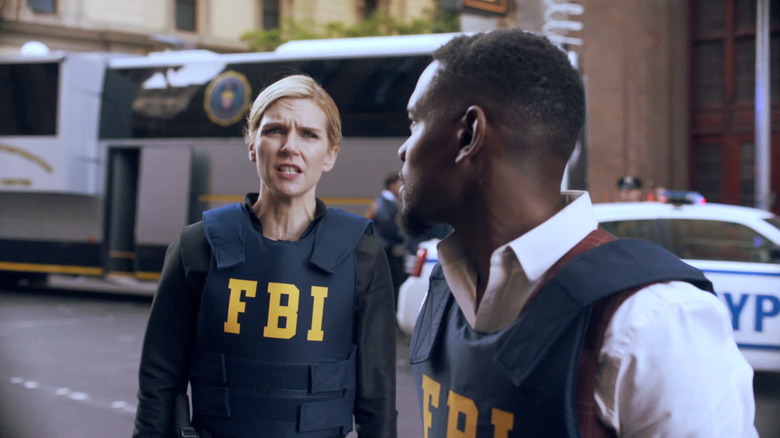Inside Man Ending Explained
Who out there hasn't stood in line at the bank, looked around at the layout and the guards and the security cameras, and wondered: How could I rob this place and get away with it? I bet some of you have even figured out what kind of masks your crew would wear. It's a fun game to play and maybe that's why we all love a good heist flick. They give us the vicarious thrill of taking part in a masterplan for a few hours and be part of the gang while wondering how exactly they're going to pull it off.
Spike Lee's "Inside Man" ranks among the most enjoyable modern capers and one of his 8 best movies overall. Released in 2006, Lee assembled a superb cast including Denzel Washington, Clive Owen, Jodie Foster, Christopher Plummer, Willem Dafoe, Chiwetel Ejiofor, and a host of great character actors for a twisty thriller that was both up-to-date and a loving homage to the gritty New York-set crime flicks of the 1970s, most notably "Dog Day Afternoon." The Big Apple is a major character in the movie, portrayed as a city still healing but also moving forward after the terrible events of 9/11. It's one of the most purely entertaining films in the director's career, but it is also a lighter-hearted companion piece to his mournful "25th Hour" with themes of wealth and power in the aftermath of the tragedy.
That's the backdrop for the gripping tale of Dalton Russell (Owen), a mysterious criminal who boasts about pulling off the perfect bank job, and Keith Frazier (Washington), the brash detective tasked with managing the hostage situation at the branch. We discover that Russell has motives beyond getting rich involving a secret safety deposit box belonging to the founder of the bank, Arthur Case (Christopher Plummer). Russell insists the standoff will end with him walking out the front door with the loot, but how exactly does he expect that to work? And is there a deeper meaning behind the clever twist ending?
What you need to remember about the plot of Inside Man
"Inside Man" opens with master thief Dalton Russell (Owen) directly addressing the camera, telling us to pay attention because he has perpetrated the perfect bank robbery. During this sequence we get a little snapshot of him killing time in what appears to be a prison cell, although he is deliberately vague about that detail. Our appetites duly whet, we skip back in time to see how it all went down.
Russell and his gang enter a Manhattan bank dressed as painters, moving their gear inside without anyone noticing. Russell disables the security cameras while his crew seize control and take everybody inside hostage, forcing them to wear the same jumpsuits and face masks as the robbers. Now with the run of the bank, the perps seem more interested in the store room than the open vault of cash. Occasionally, the gang switch blindfolded hostages from room to room and insert themselves into the groups.
A passing cop notices smoke emerging from the front doors and calls the incident in. Detective Keith Keith Frazier (Washington) and his partner Bill Mitchell (Ejiofor) are assigned to handle negotiations in the absence of their boss. Frazier harbors ambitions of making detective first-grade but he is subject of a pending investigation regarding missing money from a previous case. A bank employee is released with a metal case containing a list of demands including food for the hostages, and the cops take the opportunity to bug a stack of pizzas. All they manage to overhear is a recording of a speech by former Albanian leader Enver Hoxha, leading Frazier to deduce that Russell is anticipating their every move.
Meanwhile, Arthur Case (Plummer) has been notified about the hostage situation at his bank. He hires high-end fixer Madeline White (Jodie Foster) to protect the contents of his safety deposit box, indicating that it could prove ruinous for his reputation. White uses her influence in high places to get herself into the crime scene, where she first tries to manipulate Frazier with threats. He refuses, but allows her to enter the bank to speak to Russell and secure the safety deposit box. She's evidently a slick operator, but even she is surprised to find Russell is a few steps ahead of her.
What happened at the end of Inside Man?
Russell has already opened Case's stash in the vault. Inside, he has found a red ring box, drawstring bags we assume to contain diamonds, and papers bearing the insignia of the Third Reich. He rejects White's lucrative offer and implies that he knows Case founded the bank with money stolen from victims of the Holocaust during World War II.
Now it is Frazier's turn to enter, on the pretense of checking the hostages before complying with the rest of Russell's demands. His real goal it to ascertain whether the robbers are as dangerous as they say and tests it out by attacking Russell. It's a risky gamble that backfires as a hostage is executed. This results in the police chief pulling the plug on negotiations and calling the NYPD Emergency Service Unit to storm the building. They're about to go in when Frazier discovers that the metal case containing the ransom demands is bugged and that Russell has overheard the entire plan for the assault.
The gang assembles the hostages, blow the doors, and run out into the street. Now we fully understand why Spike Lee has been intercutting interrogation scenes showing Frazier and Mitchell grilling the hostages. The robbers have mingled with the civilians and have no incriminating evidence on them. Exploring the bank throws up more puzzles: Not a penny in the vault has been touched; the guns used by the robbers were fake; and the execution was staged. What exactly were they doing in there?
Unable to prove that anyone leaving the bank was part of the robbery, Frazier is instructed to bury the case. He's not that kind of guy and further digging reveals that Case's safety deposit box is not listed in the bank itinerary. He obtains a search warrant from the court and White shows up to warn him off. Frazier won't be intimidated, however; he was wily enough to record their earlier conversation as insurance. White doubles down on her threat, arguing that Case is no worse than many other rich people in America: "When there's blood on the streets, buy property. I think Mr. Case really took that sentiment to heart." We're now ready for the most satisfying part of a heist movie: The big reveal.
How the twist ending of Inside Man plays out
White confronts Case, telling him that she has pulled strings to get Frazier promoted in an attempt to keep him under control. She also reveals that she knows why Case wanted to keep the contents of the box secret. He admits that he got rich doing a deal with the Third Reich and also tells her about the most damning piece of evidence: a Cartier diamond ring that belonged to a Jewish friend he sold out who died in a concentration camp as a result. We get the feeling White's conscience has been pricked, but she still accepts her fee.
We return to Russell's opening monologue and see that he wasn't in a prison cell, just as he hinted at the start of the movie. Instead, he is holed up behind a false wall in the store room constructed by his gang during the robbery. After a week, he emerges from his hiding place with the diamonds and walks out the front door as he planned all along — just as Frazier and Mitchell enter to open Case's box. His gang is waiting outside and they tip him off; Russell bumps into Frazier as they pass in the foyer.
We see that a Jewish professor who posed as one of the hostages is part of Russell's crew. Checking the loot, he asks Russell where the Cartier ring is. Russell has left it in the box as a clue to lead Frazier to Case's dark secret, reasoning it will allow him to look himself in the mirror after stealing from a man with blood on his hands: "Respect is the ultimate currency."
Frazier and Mitchell confront Case about the robbery, White's involvement, and the mystery box. Case pleads his ignorance but Frazier shows him the ring. Following the lead further and finding out the truth, Frazier interrupts a meeting between White and the Mayor. He prompts White to turn Case into the War Crimes department in Washington and gives her the recording, leaving her with enough doubt that there may be copies. Now he heads home to his girlfriend and finds that Russell left a little token of respect in his pocket when they bumped into each other: A single diamond.
What the ending of Inside Man means
"Inside Man" is probably Spike Lee's most crowd-pleasing movie, but he typically has more serious things on his mind. Perhaps the key line is White's paraphrasing of the old adage "Buy when there's blood in the streets, even if the blood is your own." This refers to the contrarian investment principle that dire circumstances are the best time to invest, a kind of unsavory opportunism that proved true during World War II and in the wake of the September 11 attacks. It's an uncomfortable fact that unscrupulous individuals make a lot of money from a crisis, and Arthur Case certainly took advantage of it when he sold out his Jewish friends for profit.
This notion links the screenplay's themes of wealth and corruption with the atrocities of the Holocaust and 9/11. Tellingly, Spike Lee shot "Inside Man" on location in Manhattan's financial district just around the corner from Wall Street, often a byword for greed and shady practices. In the background the city is still rebuilding and people are still making a lot of money not far from where One World Trade Center was rising in the place of the Twin Towers — a beacon of hope, for sure, but also a very lucrative piece of real estate.
The dubious trickle-down economics of cutting deals during dark times taints the four main characters in the movie. Case has spent his entire life trying to atone for his choices, but his nefarious involvement with Nazi Germany still made him an extremely wealthy man. White makes a good living from cleaning up after people like Case and no deed is too dirty to make her leave cash on the table. When she gets a chance to do the right thing and rip up the check for her services, she just scolds him and keeps it instead.
Russell is presented as a Robin Hood-style figure, masterminding an almost victimless crime and threatening to expose a war profiteer. But he stops short of actually revealing Case, leaving it to Frazier as he makes off with the diamonds. Frazier also becomes a third-hand beneficiary of Case's murky past with the diamond Russell slips him, because even the good guys get rich from blood in the streets in "Inside Man."
Inside Man eventually got a sequel...but not from Spike Lee
"Inside Man" was generally well-received by critics and performed well at the box office, becoming Spike Lee's highest-grossing movie to date. The director's work doesn't lend itself to sequelization often, but the financial success and commercial nature of his heist movie made it a prime candidate for a follow-up. In November 2006, it was announced that Lee was teaming up again with producer Brian Glazer and screenwriter Russell Gewirtz. At that point, details were scarce and it wasn't clear whether a sequel would feature the same characters, or indeed the actors who played them in the original.
Three years later, Lee revealed that Gewirtz had departed the project along with his screenplay involving a diamond heist, and Terry George ("Hotel Rwanda") was taking over writing duties. Tantalizingly, although Lee didn't reveal what the new story would be about, he teased the return of Denzel Washington, Clive Owen, and Chiwetel Ejiofor when their schedules allowed. In April 2010, rumors that "Inside Man 2" was close to completion were squashed by Lee, who told ESPN that "it didn't work out." He touched upon it again in the following summer while lamenting his difficulties securing funding from studios. He told Hollywood Reporter:
"'Inside Man' was my most successful film... But we can't get the sequel made. And one thing Hollywood does well is sequels. The film's not getting made. We tried many times. It's not going to happen."
A belated sequel eventually arrived in the form of M.J. Bassett's "Inside Man: Most Wanted," a direct-to-video afterthought that turned out to be the follow-up nobody wanted. Also released as filler on Netflix and other streaming platforms, it was generally not regarded as a worthy successor to Spike Lee's most successful film. The low-budget production rehashed elements of the original's plot with a cast of vaguely recognizable faces, most notably Rhea Seehorn of "Better Call Saul" fame.
